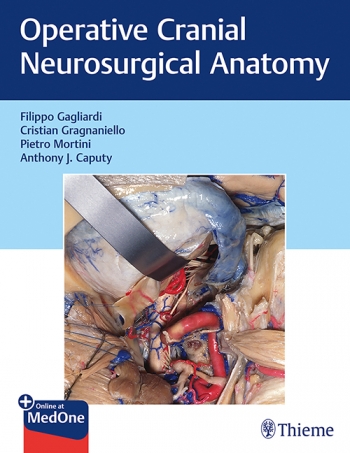
One-of-kind textbook provides comprehensive tutorial on cranial anatomy with step-by-step text and visuals
Dissection in the anatomical laboratory is a mandatory component of training for neurosurgeons. Acquisition of highly
technical skills is a long and arduous task, requiring knowledge of complex surgical anatomy and basic steps for
single surgical approaches. Unlike dense textbooks, Operative Cranial Neurosurgical Anatomy by Filippo Gagliardi,
Cristian Gragnaniello, Pietro Mortini, and Anthony Caputy provides readers with a user-friendly tutorial on cranial
approaches, clearly delineated through concise written instructions and serial images.
Essential procedural aspects are discussed in 53 chapters, starting with sections on pre-surgical training and
planning, patient positioning, and basic techniques. Subsequent sections detail cranial approaches; transpetrosal
approaches; endonasal, transoral, and transmaxillary procedures; vascular procedures; and ventricular shunts
procedures. Surgical technique fundamentals and basic variants, including surgical anatomy and landmarks, are
highlighted in 500 figures and illustrations.
Key Features
• Summaries, graphics, and schematic drawings provide immediate access to salient information to utilize
during surgical dissections and for surgical preparation
• A wide spectrum of cranial procedures covered in 23 chapters – from the precaruncular approach to the
medial orbit and central skull base – to surgical anatomy of the petrous bone
• Diverse endonasal procedures including sublabial, transphenoidal, modified lothrop, odontoidectomy, and
endoscopic endonasal transmaxillary
• Vascular procedures such as middle cerebral artery bypass and internal maxillary artery bypass
This reader-friendly handbook is a must-have resource for every neurosurgical resident and an excellent refresher
for all neurosurgeons. It will help residents and fellows optimize the time and quality of practical training in the
cadaver lab, learn fundamental surgical techniques in cranial neurosurgery, and thoroughly prepare for cranial
neurosurgical cases.
This book includes complimentary access to a digital copy on https://medone.thieme.com.
Part I: Presurgical Training
1 Training Models in Neurosurgery
2 Assessment of Surgical Exposure
Part II: Planning, Patient Positioning, and Basic Techniques
3 Anatomical Landmarks and Cranial Anthropometry
4 Presurgical Planning By Images
5 Patient Positioning
6 Fundamentals of Cranial Neurosurgery
7 Skin Incisions, Head and Neck Soft-Tissue Dissection
8 Techniques of Temporal Muscle Dissection
9 Intraoperative Imaging
Part III: Cranial Approaches
10 Precaruncular Approach to the Medial Orbit and Central Skull Base
11 Supraorbital Approach
12 Trans-Ciliar Approach
13 Lateral Orbitotomy
14 Frontal and Bifrontal Approach
15 Frontotemporal and Pterional Approach
16 Mini-Pterional Approach
17 Combined Orbito-Zygomatic Approaches
18 Midline Interhemispheric Approach
19 Temporal Approach and Variants
20 Intradural Subtemporal Approach
21 Extradural Subtemporal Transzygomatic Approach
22 Occipital Approach
23 Supracerebellar Infratentorial Approach
24 Endoscopic Approach to Pineal Region
25 Midline Suboccipital Approach
26 Retrosigmoid Approach
27 Endoscopic Retrosigmoid Approach
28 Far Lateral Approach and Principles of Vertebral Artery Mobilization
29 Trans-Frontal-Sinus Subcranial Approach
30 Transbasal and Extended Subfrontal Bilateral Approach
31 Trauma Flap and Osteo-Dural Decompression Techniques
32 Surgical Anatomy of the Petrous Bone
Part IV: Transpetrosal Approaches
33 Anterior Petrosectomy
34 Presigmoid Retrolabyrinthine Approach
35 Translabyrinthine and Transcochlear Transpetrosal Approach
Part V: Endonasal, Transoral, and Transmaxillary Procedures
36 Nasal Surgical Anatomy
37 Microscopic Endonasal and Sublabial Approach
38 Endoscopic Endonasal Transphenoidal Approach
39 Expanded Endoscopic Endonasal Approach
40 Endoscopic Endonasal Modified Lothrop Approach to Anterior Cranial Fossa
41 Endoscopic Endonasal Odontoidectomy
42 Endoscopic Transoral Approach
43 Transmaxillary Approaches
44 Transmaxillary Transpterygoid Approach
45 Endoscopic Endonasal Transclival Approach with Transcondylar Extension
46 Endoscopic Endonasal Transmaxillary Approach to the Vidian Canal And Meckel's Cave
Part VI: Vascular Procedures
47 Superficial Temporal Artery & Middle Cerebral Artery Bypass
48 High Flow Bypass (Common Carotid Artery & Middle Cerebral Artery)
49 Middle Cerebral Artery & Internal Maxillary Artery Bypass
Part VII: Ventricular Shunts Procedures
50 Anthropometry for Ventricular Puncture
51 Ventricular-Peritoneal Shunt
52 Endoscopic Septostomy
53 Endoscopic Third Ventriculostomy and Biopsy of Pineal Region


